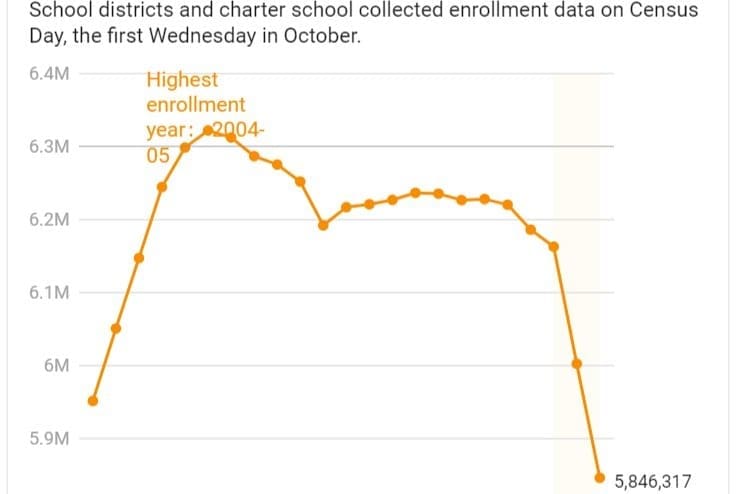DR. CHRISTINA M. KISHIMOTO | JUNE 2022
 As we figure out our way past the ever-present pandemic, school districts are managing their way through two student attendance matters: dropping enrollments and student absenteeism. The former means an already stressful teacher shortage situation is creating additional distress with the need for teachers to move to existing vacancies at other schools as FTEs are reduced across districts. California’s 6 million student enrollment for example, dropped almost 2% just in this past year alone, after a steady decline in enrollment since 2014-15 when enrollment was at 6.24 million, reaching a new low at 5.85 million. In a conversation recently with a teacher from California, she shared that she is feeling stressed from yet another change, but is staying positive because she continues to have a teaching position within her district where she has great relationships with her peers. Relationships matter deeply; even more so during these unknowing times.
As we figure out our way past the ever-present pandemic, school districts are managing their way through two student attendance matters: dropping enrollments and student absenteeism. The former means an already stressful teacher shortage situation is creating additional distress with the need for teachers to move to existing vacancies at other schools as FTEs are reduced across districts. California’s 6 million student enrollment for example, dropped almost 2% just in this past year alone, after a steady decline in enrollment since 2014-15 when enrollment was at 6.24 million, reaching a new low at 5.85 million. In a conversation recently with a teacher from California, she shared that she is feeling stressed from yet another change, but is staying positive because she continues to have a teaching position within her district where she has great relationships with her peers. Relationships matter deeply; even more so during these unknowing times.
Something else matters deeply – what our children observe of adult behaviors. There is so much that we can talk about relative to that statement, but I want to focus on recent and repeated concerns about how to address this year’s increase in student absenteeism. It’s one of the surprising outcomes of the pandemic. Some students have decided that they don’t want to come to school, and if you talk to parents, they are not so sure how they feel about this. As I hear numerous conversations from educational leaders discussing strategies for supporting the psychological safe return of students to schools, and discussing how to design the school day so that students want to be back at school, I am struck by the irony of these conversations. As we enter the midterm elections, a whopping 36 states have a gubernatorial election, in addition to congressional seats being challenged. This is no small matter in light of what appears to be a growing national agenda by some influential congressional members to increase state policy power on matters from what is taught and not taught at schools, to women’s reproductive rights, to second amendment rights. The Supreme Court is also leaning more conservative and state oriented, which threatens to challenge hard-won national level civil right policies by redirecting more policy power to states. So what does this have to do with our challenge with student attendance?

With so many state and congressional seats at stake across the nation, and the fight for state rights being predicated on a ultraconservative pillar of anti-civil rights, anti-immigrant, anti-equality sentiments, we are at a crossroads where as a nation we will either elect caring equity-focused leaders who will continue the challenging but important work around anti-racism, justice and equity of access, or we will go down a path where we turn back the clock on what progress has been made in the past century. Considering that one of the most important rights women and people of color fought for in this country was the right to vote to determine their representatives – their policy makers, one might reasonably expect that the polls would be flooded with voters on election day.
But that is not the case, and here’s what I am wondering. While we as adults are mystified by student absenteeism, perhaps we need to take our own attendance… at the polls. On average for the past three decades, our midterm voter turnout has barely tipped 40% of eligible voters, and at times has dipped down to about 36% (Bloomberg, Dec, 2018) Additionally, the Hispanic and Asian electorate turned out to vote at the 2018 midterm elections at a 17% lower rate than Whites; Black voters turned out at a rate 6% lower than Whites – and this was a midterm election that saw a significant increase in the turnout of voters (Pew Research). Our complacency as empowered voters has been evident for years. Despite the significant policy matters at stake that directly impact our democracy, civil rights, fair representation and community voice, elections are being won through the turnout of a small, non representative part of the electorate. Additionally our young generation of adult voters are particularly not showing up at the polls. That is the example that we have set for students around the importance of showing up. Because of our collective complacency at the polls we are turning over our future to extremists and individualists who do not care about our children and youth of color. Make no mistake, our students are watching our actions carefully.
——————————————————
Dr. Kishimoto is the Founder and CEO of Voice4Equity and a lifelong advocate for public education.
Follow her on Twitter

